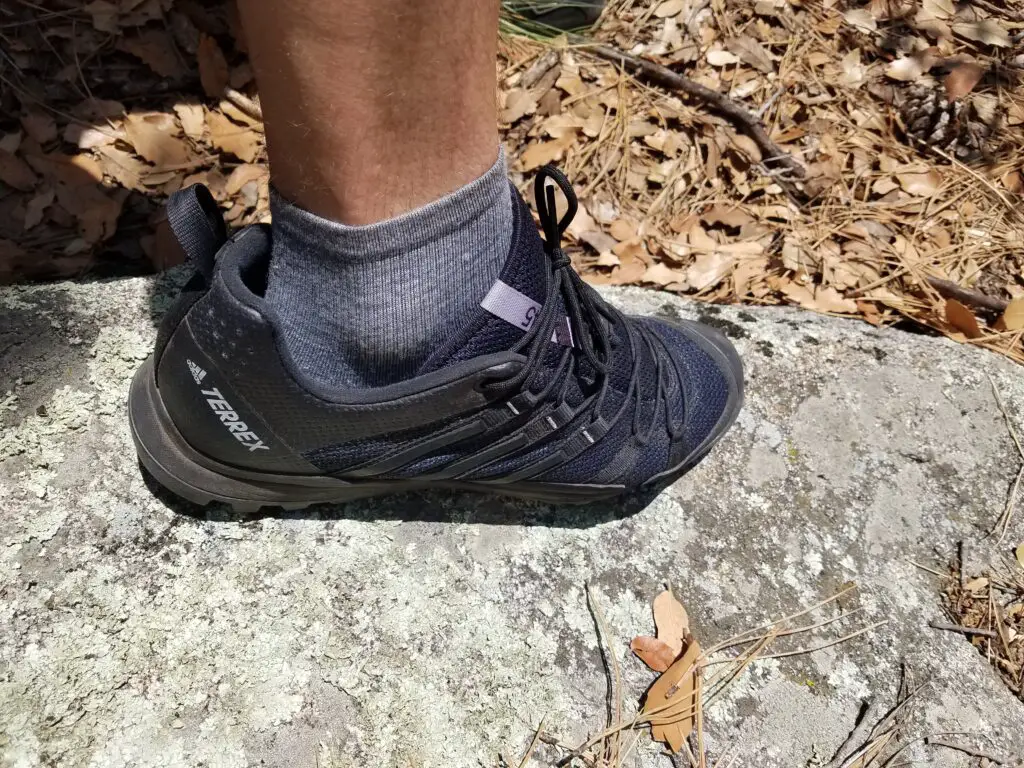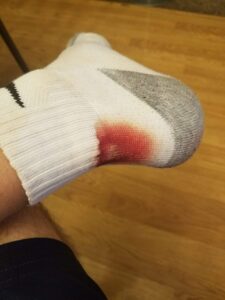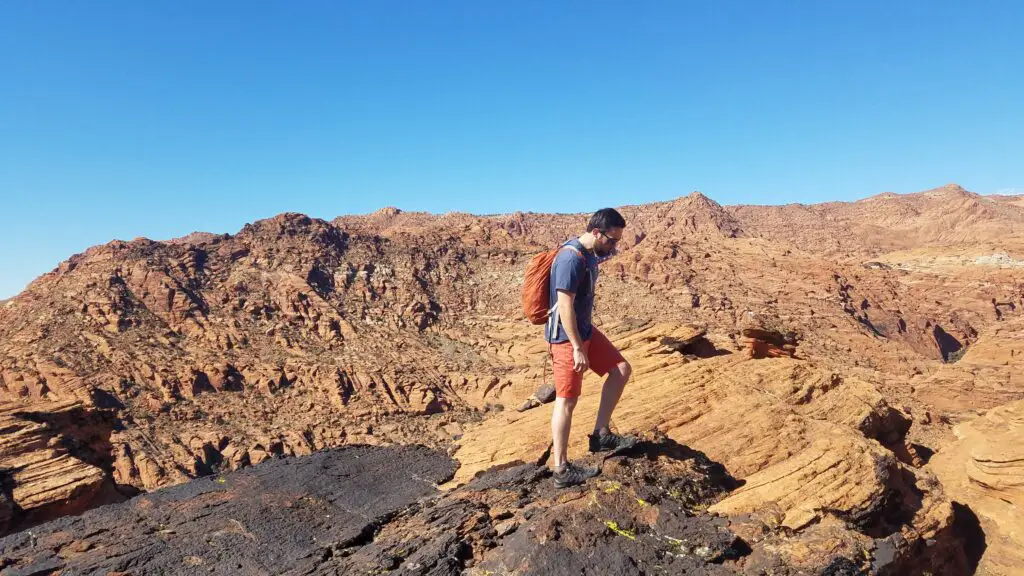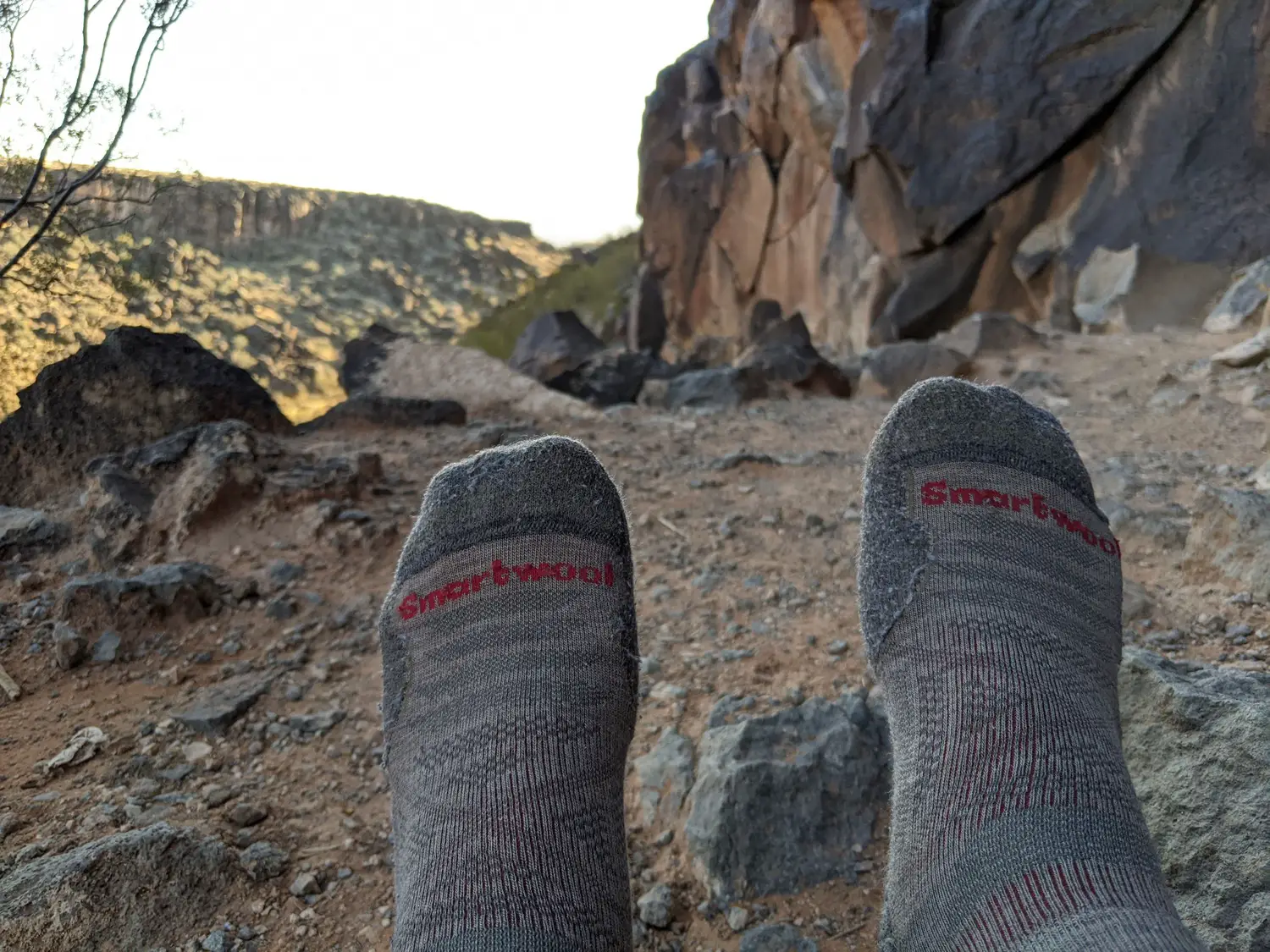Of all of the injuries hikers can expect to face in the backcountry, the most common definitely occur on their feet. Blisters, thorns, and stubbed toes, not to mention frostbite or trenchfoot, can sideline a hiker for a few days or completely ruin a trip. It’s important to shield your most vulnerable body parts from the rigors of the trail.
Hiking socks are made from superior materials like merino wool that can adapt to varied temperatures and conditions, ensuring that you aren’t ever too warm or too cold. Beyond that, they also include padding in specific places like the ball of your foot where you can get sore spots more easily. The thick, tough (and soft) wool helps reduce instances of blisters and hot spots on your feet as well.
I do have to say- I love socks. If I ever reach the point where money is not an object, I think I’ll wear a brand new pair of socks every single day. Hiking socks are expensive though, so it can be tempting to just go without them and wear socks you already own. Here’s why that’s a bad idea-
Hiking Socks for Hiking Feet
I recently tested a pair of midweight merino wool socks over the course of a week at high elevation and medium elevation, and both wet and dry. The temperature varied from about freezing at night at high elevation to almost 90 degrees during the day at the lower elevation.
The most amazing thing to me was that the socks that kept my feet warm in the cold weather simultaneously kept my feet cool in the hot weather. Hiking 5-7 miles a day off-trail had me nervous that I’d end up with blisters or lots of problems with stickers in my feet, but the thick socks prevented all of that as well.
Now I’m not trying to sell socks- I just think you should get a pair if you like your feet, and if you like hiking. The ones I use are the Smartwool Performance Hike Socks (view on Amazon ), but there are plenty of options for wool socks that are good.
), but there are plenty of options for wool socks that are good.
The other thing I should point out is that these socks aren’t limited use for only hiking. I use them for mountain biking, class A canyoneering (what is canyoneering? ), and other outdoors activities.
), and other outdoors activities.
I still use regular socks for activities like trail running where they’ll get worn down prematurely or where there’s minimal chance of encountering unexpected conditions, but otherwise my wool hiking socks have become my go-to socks for the majority of outdoor adventures.

Why Hiking Socks are So Important
The rigors that hiking exerts on your feet are unique. You get the continuous slog of a long run or walk amplified by the uneven terrain and constant incline changes. Cap it off with the inevitable pebble in your shoe and you’ll see why regular socks just won’t cut it.
These are the features that differentiate hiking socks from regular socks, or even from socks used for running or basketball, or whatever other sports you participate in.
Warmth
One of my first experiences with wool socks was on the ski slope. I’d gotten a pair of really thick wool socks and was excited to finally have warm feet for the first time while skiing.
About halfway down the first black diamond I realized that my feet were really, really warm. The socks still wicked the sweat which was nice, but it was frustrating to have hot feet all day. I learned that those thick socks were just too much for skiing.
Merino Wool fibers are porous in that they trap little pockets of air throughout. The heat generated from your feet warms these pockets of air, creating a nice layer of insulation from outside cold air.
throughout. The heat generated from your feet warms these pockets of air, creating a nice layer of insulation from outside cold air.
Temperature Regulation
The challenge with an activity like hunting in the Fall is that with a pre-dawn start everything is really cold. You load up 4 or 5 layers, hike in somewhere, and then sit still until the sun comes up. At that point you start to warm up quickly and have to haul around all of the extra layers.
On a recent hunting trip I wore a second pair of wool socks since we planned on sitting for a long time in the morning waiting for animals to come up over the ridge in front of us. My feet were nice and warm after the approach, but then the day really got away from us before I had a chance to take a pair off.
By the time I remembered I was wearing 2 pairs of wool socks it was about 80 degrees and we had been hiking around for about an hour up and down hills. I was amazed to realize that my feet were comfortable, and more than that, they were dry!
Wool’s secret is that it comes from sheep! They’re able to live comfortably with a big wool coat in both hot and cold climates throughout the summer and winter.

Blister Prevention
Moleskin is good, duct tape is better, but you know what’s even better? Not needing to worry about blisters at all.
Blisters form when part of your shoe or sock rubs against part of your foot repeatedly. This happens most often on seams in your sock toes, when socks get bunched up, or when boots are just so stiff they don’t mold around your foot or ankle.
Hiking socks help with this because they’re often thicker than regular socks and are often made of multiple layers of wool. These layers move independent of each other so that any friction occurs between them rather than against sensitive spots on your feet. The thick padding also helps to reduce blisters.
I’m not going to guarantee that hiking socks will completely alleviate any risk of blisters- you still need to break in your shoes before tackling a long hike. This is why I’ve mostly switched over from stiff hiking boots to trail running shoes (mostly).
Moisture Wicking
I got to test out wool’s moisture wicking capabilities firsthand on a hunt for about a week up at 11,000 feet in the Uintah Mountains in Utah. We backpacked in about 3 miles and set up a base camp. I’ve pretty much completely ditched hiking boots for trail running shoes due to the comfort and cost, but this time it came back to bite me.
for trail running shoes due to the comfort and cost, but this time it came back to bite me.
We got rained on just about every 2 hours with storms rolling in over the peaks above our heads. The rain made the long grass wet, which meant each step was squirting my non-waterproof shoes with cold water. It didn’t take long for the water to seep in through my shoes and into my socks.
In that weather, my feet were wet for the rest of the hunt and there was little I could do to dry everything out. Had I worn cotton socks, there would have been no way to keep my feet warm once they’d initially gotten wet.
With wool hiking socks however, I could easily squeeze out the water and they’d go right back to keeping my feet warm. While they’re wet they still even do a decent job insulating your feet as they work similar to a wetsuit by helping to warm the water trapped between the sock and your feet.
by helping to warm the water trapped between the sock and your feet.
When cotton socks get wet, the material bunches up and you can quickly form a blister. Not only do they not insulate your feet against the cold, but they cause pain as well.
Odors and Bacteria
The moisture wicking feature not only keeps your feet warmer as it keeps them dry, but also reduces the buildup of nasty odors and the associated bacteria. The sweat from your feet and dust from the environment you’re treading through combine to create a nice cesspool of stuff that you don’t want to latch on to your toes.
and the associated bacteria. The sweat from your feet and dust from the environment you’re treading through combine to create a nice cesspool of stuff that you don’t want to latch on to your toes.
This harmful bacteria can cause serious problems on your feet during a long multi-day hike as it can lead to different types of fungus that not only stink, but also cause pains and sores.
Comfort and Padding
Forget the scratchy wool sweaters you remember as a kid. Modern wool socks are plush! Most pairs are about 50% merino wool with the rest being a combination of synthetic materials like nylon or spandex to help keep the shape over time.
When you hold them in your hands you’ll find that they feel a lot more thick than other socks, even after they’ve been worn and washed a bunch. This comfort is the beauty of hiking socks.
Durability
Companies like Darn Tough and Smartwool
and Smartwool have built a brand around being indestructible (indestructawool). This is obviously appealing, due to the high prices they command.
have built a brand around being indestructible (indestructawool). This is obviously appealing, due to the high prices they command.
Of course, they are going to wear out eventually as all things do. If you’re careful not to snag them on anything though, they’ll last a lot longer than regular socks. Not only are they more padded than other socks, the material is also a lot more dense so it wears slower.
Wool fibers are much more durable than cotton fibers (animal versus plant)- up to 10 times more durable ! This durability means they’ll handle continual rubbing within your shoes better than cotton, but they’ll also hold their shape better and won’t pill apart like cotton does.
! This durability means they’ll handle continual rubbing within your shoes better than cotton, but they’ll also hold their shape better and won’t pill apart like cotton does.

What to Look for in Hiking Socks
Like I said, I have enjoyed my SmartWool socks, but I do think they’re pretty over-priced and there are plenty of options out there that are made from similar merino wool weaves. Here’s what you’re really looking for in hiking socks.
Merino Wool
This is definitely the most important feature for hiking socks, since that’s the main thing that separates them from a good pair of running socks or socks for any other sport. Most of the pairs I’ve looked at are above 50% wool.
You want a good balance between wool and something synthetic like spandex or nylon so that they stay tight against your feet without bunching up or sagging down.
Thickness
I shared a few stories above about socks that are too thick, but I’ve also got a pair that is so thin that my feet just kind of slide around in my approach shoes . The thin ones were nice when I lived in Arizona and are nice on the hottest of days, but the midweight pairs are best for anything in the mountains or in moderate weather.
. The thin ones were nice when I lived in Arizona and are nice on the hottest of days, but the midweight pairs are best for anything in the mountains or in moderate weather.
Fit
While lots of socks are listed as ‘one size fits all,’ that’s not ideal. You want a pair that matches your street shoe size so that they aren’t too loose (blisters) or too tight (premature wear).
Length
The length of socks is best determined by the type of hiking shoes you use. Crew cut socks are usually too short for hiking shoes since they tend to hug your ankles more than regular shoes. Ankle height or mid-calf height socks are best for hiking.
Durability
There are tons of different brands that make good socks, so it’d be difficult to test them all rigorously and determine which is the best value. The name brands are sure to be durable and functional, but you’ll definitely pay a little bit extra for that peace of mind.
Related Questions
How Much do Hiking Socks Weigh? Hiking socks weigh between 1.5 and 2 ounces (.05kg). The difference between a lightweight pair and a thicker pair is minimal, even for ultralight backpackers or long-distance hikers. A thick pair that is sure to last the rigors of a hike is much lighter than two pairs of lighter pairs.
Do Hiking Socks Make a Difference? Hiking socks reduce the risk of blisters and hot spots on hiker’s feet. Additionally, they help to regulate the temperature of the feet during both hot and cold weather thanks to the material they’re made from. Hiking socks also have extra padding that helps to reduce soreness in specific locations on the feet.
Do You Have to Wear Hiking Socks? Socks specifically designed for hiking are certainly optional; however, if you intend to do a long hike or to hike for multiple days, they are recommended. Hiking socks reduce blisters, help with temperature regulation, and provide additional padding. Regular socks can bunch up easier, wear though easier, and cause blisters and other issues.
How Often Should You Change Your Socks Hiking? For multi-day hiking trips, it’s important to change out socks daily whenever possible. Experienced hikers usually put on the next day’s socks at bedtime the night before so they can sleep in a fresh pair of socks each night, allowing their feet to breathe better while still staying warm.

